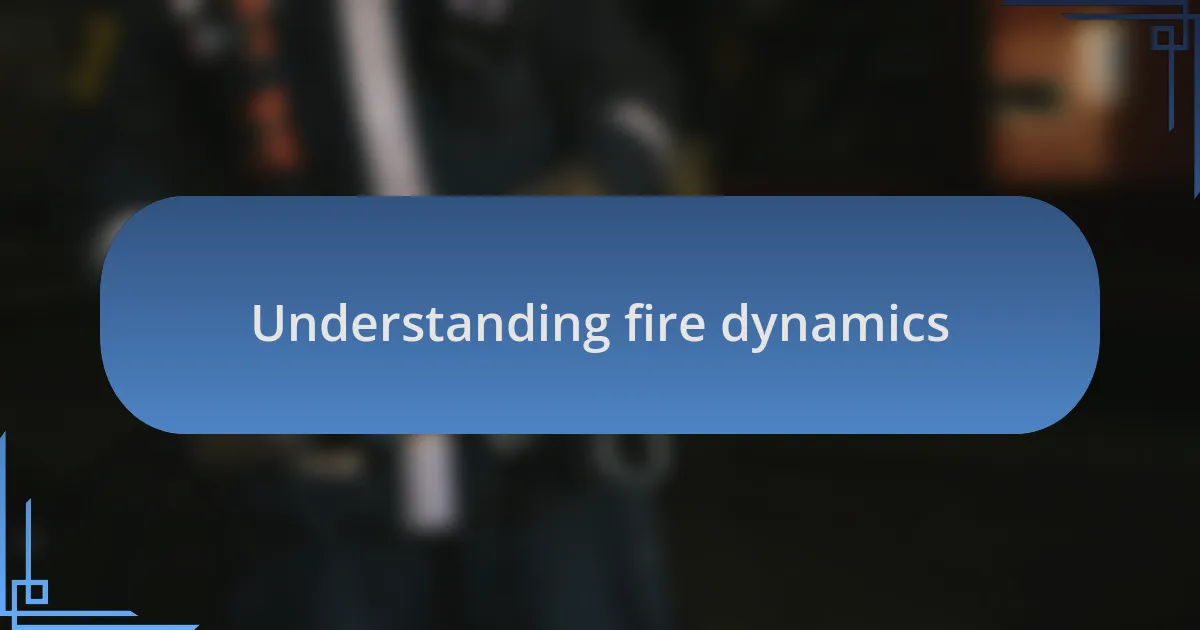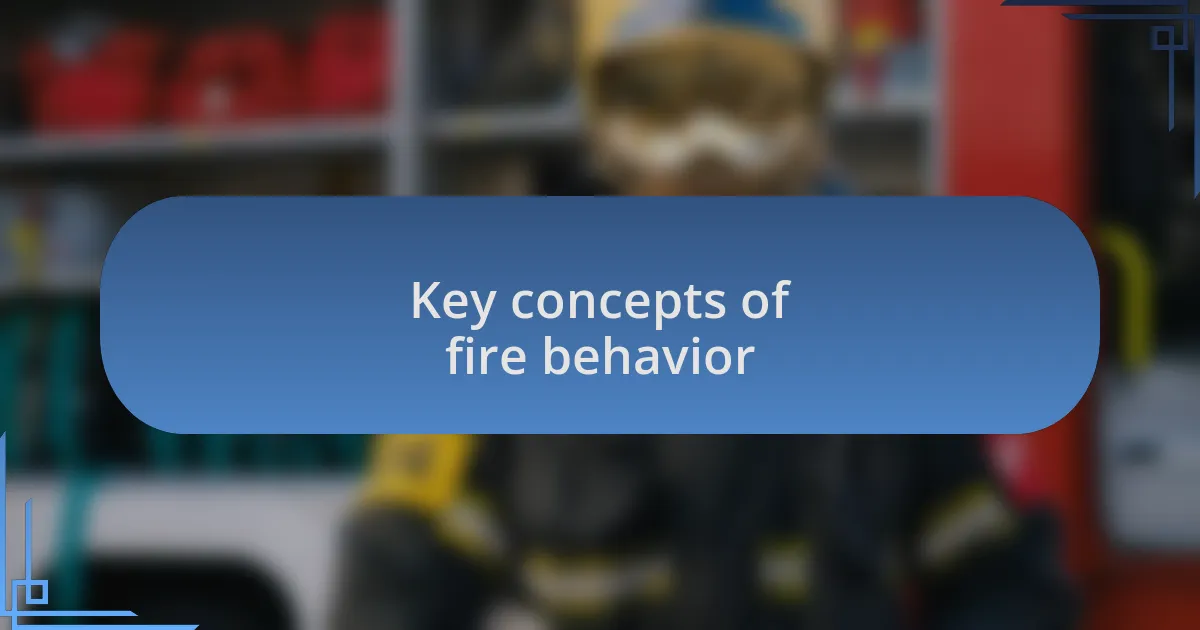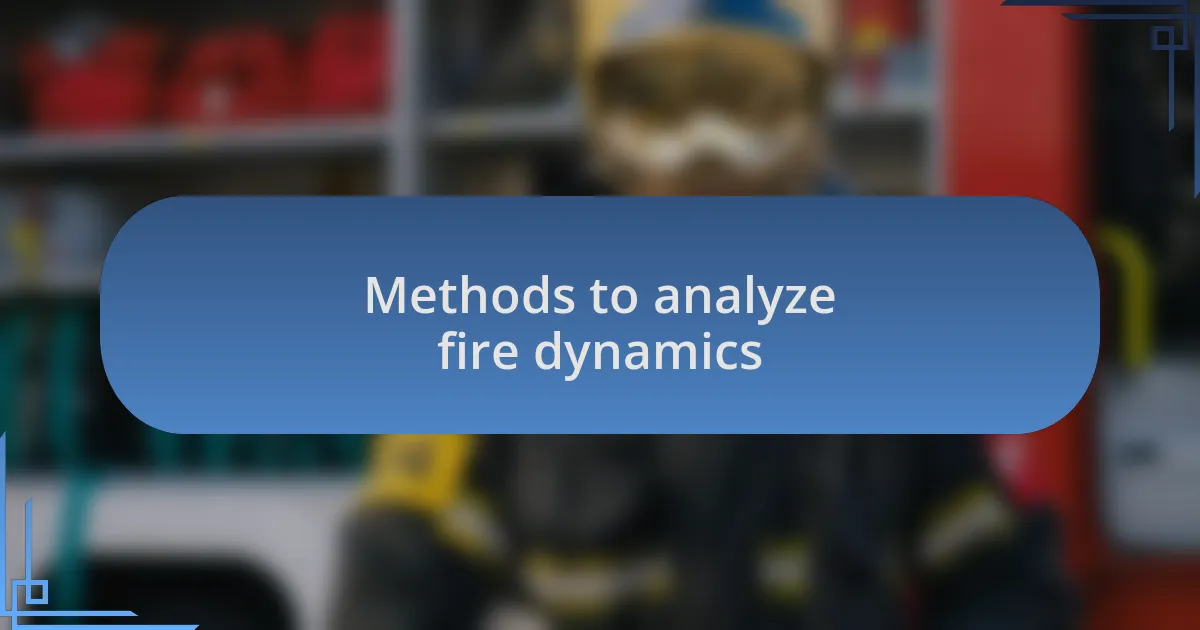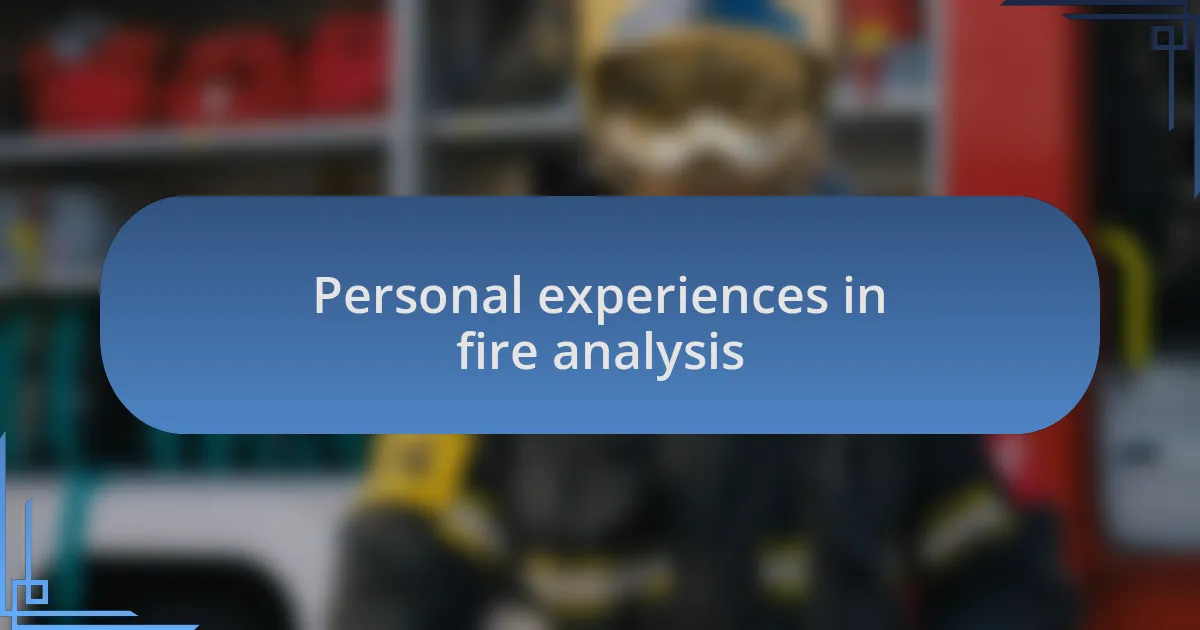Key takeaways:
- Fire dynamics involves understanding the fire triangle (heat, fuel, oxygen) and the critical role of ventilation in fire spread.
- Thermal layering and flashover are essential concepts that influence fire behavior and require tactical awareness in firefighting.
- Analytical methods like CFD modeling, live-fire training, and historical fire data are crucial for predicting and understanding fire dynamics.
- Tools such as thermal imaging cameras and fire behavior prediction software enhance decision-making and strategy in fire management.

Understanding fire dynamics
Fire dynamics is a fascinating intersection of physics and chemistry, explaining how fires start, spread, and extinguish. Each time I step onto a training ground, I see firsthand the dance of flames and heat, and it never ceases to amaze me how something that appears chaotic follows specific scientific principles. If you think about it, understanding these patterns gives us the upper hand — don’t you agree?
One critical aspect of fire dynamics is the concept of the fire triangle: heat, fuel, and oxygen. I remember my first training session where we routinely broke down this triangle into components, which really helped me grasp why certain environments can ignite so easily. It was eye-opening to see how a simple shift in any of these elements could drastically alter a fire’s behavior.
Another crucial factor is the presence of ventilation. I once witnessed how quickly a seemingly contained blaze turned into a raging inferno simply due to a window being broken. It’s moments like these that truly underscore the importance of understanding fire dynamics — it’s about reading the room and making quick decisions to mitigate danger. How could we tackle a situation effectively without this knowledge?

Key concepts of fire behavior
One of the most essential concepts in fire behavior is the idea of thermal layering. I vividly remember an exercise where we observed how heat rises and cool air settles, creating distinct temperature zones in a structure. Seeing how this phenomenon could impact both the spread of fire and our approach to ventilation taught me the importance of tactical positioning. Have you ever noticed how one side of a room can feel significantly hotter than the other? That’s thermal layering in action.
Another fundamental principle is the concept of flashover. I still recall my first training drill simulating this deadly transition, where flames rapidly engulfed the entire room, making it clear how quickly everything can change. It pushed home the reality that timing is everything. One moment you might feel in control, and the next, the environment can shift dramatically, demanding constant vigilance. Isn’t it incredible how a moment’s lapse in attention can lead to such drastic consequences?
Lastly, we can’t overlook the influence of fire load, which refers to the amount and type of combustible materials in an area. I distinctly remember a scenario where the presence of cardboard boxes and paper products escalated a small fire into a full-blown emergency. It became clear that understanding fire load not only helps us predict fire behavior but also enables us to make informed decisions on prevention strategies. Who would have thought that something as simple as the materials in a room could pose such significant risks?

Methods to analyze fire dynamics
Analyzing fire dynamics involves several methods that can help us predict and understand fire behavior in real-time. One approach I find particularly useful is computational fluid dynamics (CFD) modeling. During a training session, we utilized CFD to visualize how smoke and heat would move through a building, and I recall watching the simulation unfold in real-time. It was fascinating to see how minute changes in layout could alter the flow—how does that insight change the way we prepare for real-life scenarios?
Another method I regularly employ is live-fire training, which offers firsthand experience. I remember a drill where we set controlled fires in different types of structures to see how varying materials influenced the flames’ progress. This practical exposure reinforced my understanding of fire dynamics in an intuitive way. Have you ever participated in a live exercise that completely reshaped your perspective on fire behavior?
Additionally, I pay close attention to historical fire data, which offers invaluable insights. Analyzing past incidents, I noted patterns like the impact of weather conditions on fire spread. One time, when reviewing a report on an especially fierce blaze at an abandoned warehouse, I could see how factors like wind direction and previous fire load played a critical role. Isn’t it enlightening how looking back can so profoundly inform our future responses?

Tools for fire dynamics analysis
When it comes to tools for fire dynamics analysis, one of my go-to resources is thermal imaging cameras. I vividly remember a night training session where we used these cameras to track fire hotspots that were invisible to the naked eye. The excitement of spotting a hidden ember, just waiting to reignite, really drove home the idea that understanding heat signatures can make all the difference in firefighting tactics. Have you ever had that adrenaline rush while uncovering something crucial in a blaze?
Another valuable tool is fire behavior prediction software. During a recent training exercise, we leveraged this program to simulate different fire scenarios based on various fuel types. I was amazed at how accurately the software projected the potential growth rate and spread patterns of flames. This not only helped us prepare better but also provided a clear visual aid for discussing strategies. How do you think such predictive tools can enhance your decision-making in the field?
Lastly, I find that utilizing physical modeling—scaling down environments to study fire behavior—is incredibly insightful. I participated in a workshop where we constructed miniatures of structures and ignited small fires within them. The results were astonishing, showing how different ventilation options could drastically affect the fire’s behavior. This hands-on approach not only deepened my understanding but also reinforced the critical need for thoughtful building designs in fire safety. Have you ever tried modeling fires in a controlled setting? It can be an eye-opener!

Personal experiences in fire analysis
One of my most eye-opening experiences in fire analysis happened during a real incident response. As we arrived at a building engulfed in flames, I instinctively started analyzing the smoke conditions. The color and density of the smoke offered crucial clues about what materials were burning and how I could better strategize our approach. Have you ever stood in the middle of chaos and felt the weight of those moments where your observations could make all the difference?
Another memorable moment came while I was attending a fire dynamics seminar. A veteran firefighter shared a story about a fire that spread rapidly due to a nearby gas line. Hearing his account of analyzing the ignition points and fire behavior in real-time made me realize that our training needs to adapt continuously. It made me reflect on how vital it is to keep learning and sharing our insights to improve our tactics. Have you considered how sharing personal narratives can enhance your team’s approach to fire dynamics?
During a weekend training exercise, we simulated a wildfire scenario and the unpredictable momentum it can gain. I vividly recall how we used wind direction and terrain features to anticipate the fire’s spread. The adrenaline and urgency of decision-making reminded me just how critical it is to analyze these dynamics effectively. That day reinforced my belief that practical experience is irreplaceable. Have you felt that rush of urgency when a fire’s behavior shifts unexpectedly?